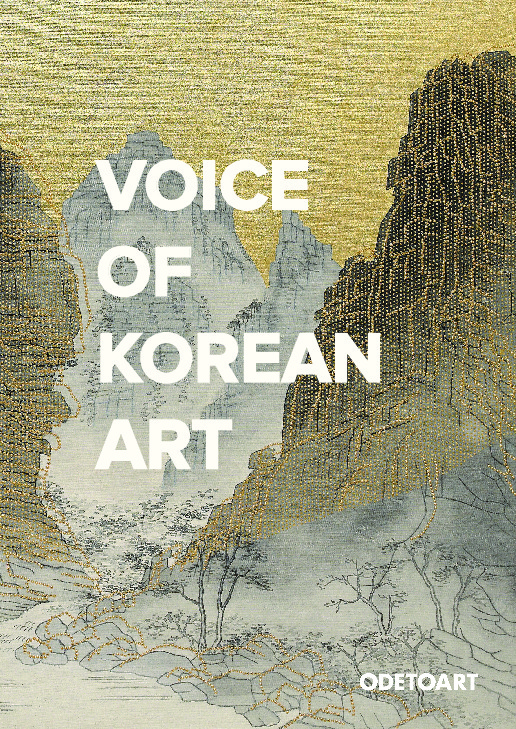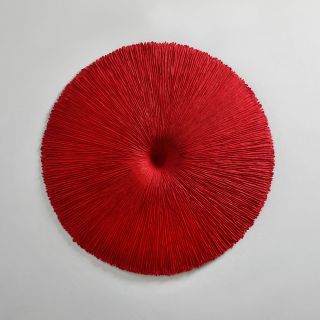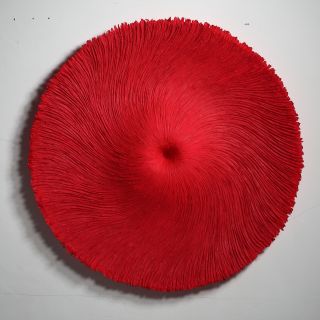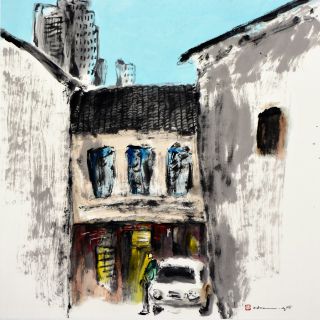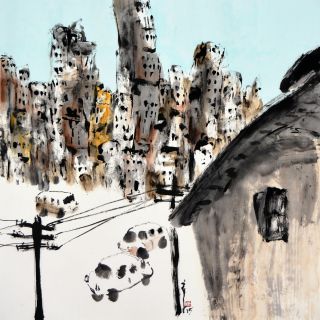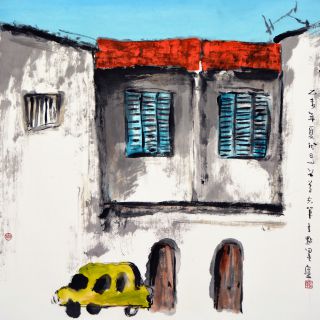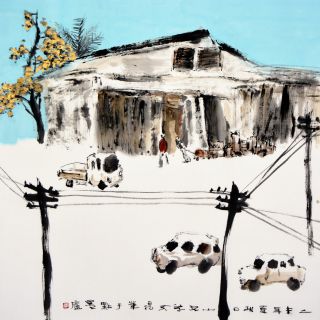Lee Young Ji was born in South Korea. She graduated from Sungshin Womans University Korea with a B.F.A and received an M.A. in Oriental Painting from Sungshin Graduate School. She is a young, promising artist who has been gaining traction with collectors through her labor-intensive drawing of trees. Her paintings of trees are full of artisan spirit and drawn with one brushstroke after another. They were recently introduced at the Asia Top Gallery Hotel Art Fair and multiple art fairs in Korea. Viewers can experience oriental paradise in her paintings, full of trees, birds, and everyday objects.
Biography 
Biography
Lee Young Ji was born in South Korea. She graduated from Sungshin Womans University Korea with a B.F.A and received an M.A. in Oriental Painting from Sungshin Graduate School. She is a young, promising artist who has been gaining traction with collectors through her labor-intensive drawing of trees. Her paintings of trees are full of artisan spirit and drawn with one brushstroke after another. They were recently introduced at the Asia Top Gallery Hotel Art Fair and multiple art fairs in Korea. Viewers can experience oriental paradise in her paintings, full of trees, birds, and everyday objects.
The artist renders her oriental paintings with a 2H pencil and fastidiously draws and colours in a repetitive motion upon the jiangji or thick mulberry paper that she uses as a medium, her finished pieces may take over a month to complete. Distinguishing herself from the traditional realm of oriental painting, the foundation for her work is inspired from the genre with the use of jiangji, a pencil in place of muk or Korean ink and adding on a layer of agyo (gelatine from the hide of animals) on top of the completed piece. Her drawings are meticulous and delicate, differing from the oil paintings of the West. Lee has been well-received by the Singapore audience through the Young Revolution exhibition at Ion Art Gallery in January 2014 and her artworks are on display at Nassim Park Residence in Singapore.
The artist renders her oriental paintings with a 2H pencil and fastidiously draws and colours in a repetitive motion upon the jiangji or thick mulberry paper that she uses as a medium, her finished pieces may take over a month to complete. Distinguishing herself from the traditional realm of oriental painting, the foundation for her work is inspired from the genre with the use of jiangji, a pencil in place of muk or Korean ink and adding on a layer of agyo (gelatine from the hide of animals) on top of the completed piece. Her drawings are meticulous and delicate, differing from the oil paintings of the West. Lee has been well-received by the Singapore audience through the Young Revolution exhibition at Ion Art Gallery in January 2014 and her artworks are on display at Nassim Park Residence in Singapore.
Exhibitions 
Exhibitions
Solo and Group Exhibitions
1998 - 2014: Nine Solo Exhibitions
2015: ‘Voice of Korean Art,’ Ode to Art Gallery, Singapore.
2014: ‘Art Southampton,’ USA.
‘Affordable Art Fair,’ Singapore.
‘Asia Contemporary Art Show,’ Hong Kong.
‘Affordable Art Fair,’ Hong Kong.
‘Deagu Art Fair,’ EXCO, Daego.
‘KIAF Korean International Art Fair,’ COEX, Seoul.
‘BAMA,’ BEXCO, Pusan.
2013: ‘MMMart,’ Artist-in-residence, Slovenia.
‘Korean-China Exchange Exhibition,’ Art Space Hyun, Seoul.
‘Tokyo Frontline,’ Arts Chiyoda 3777, Japan.
‘Galleries Association Art Fair,’ BEXCO, Pusan.
‘Asia Top Gallery Hotel Art Fair,’ Hyatt Hotel, Seoul.
‘Art Road 77,’ Gallery Puzz, Heiri.
2012: Zhang Jiajie International Oil Painting Art Workshop, Pullman Hotel, China.
‘German Contemporary Art Ruhr,’ German Essen.
‘From Hangang to Chaophraya,’ The National Gallery, Bangkok.
‘Art Osaka,’ Hotel Granvia, Osaka.
1998 - 2014: Nine Solo Exhibitions
2015: ‘Voice of Korean Art,’ Ode to Art Gallery, Singapore.
2014: ‘Art Southampton,’ USA.
‘Affordable Art Fair,’ Singapore.
‘Asia Contemporary Art Show,’ Hong Kong.
‘Affordable Art Fair,’ Hong Kong.
‘Deagu Art Fair,’ EXCO, Daego.
‘KIAF Korean International Art Fair,’ COEX, Seoul.
‘BAMA,’ BEXCO, Pusan.
2013: ‘MMMart,’ Artist-in-residence, Slovenia.
‘Korean-China Exchange Exhibition,’ Art Space Hyun, Seoul.
‘Tokyo Frontline,’ Arts Chiyoda 3777, Japan.
‘Galleries Association Art Fair,’ BEXCO, Pusan.
‘Asia Top Gallery Hotel Art Fair,’ Hyatt Hotel, Seoul.
‘Art Road 77,’ Gallery Puzz, Heiri.
2012: Zhang Jiajie International Oil Painting Art Workshop, Pullman Hotel, China.
‘German Contemporary Art Ruhr,’ German Essen.
‘From Hangang to Chaophraya,’ The National Gallery, Bangkok.
‘Art Osaka,’ Hotel Granvia, Osaka.
Critique 
Critique
Cosmos with Dancing Green Particles
by Lee Sun Young, Art Critic
The tree painted by Lee Young Ji is incomplete as it does not show the monumental size of the tree that extends loftily into the sky and is rooted deeply into the ground. The weak trunk stretching out thinly under the greenish spots only alludes to the tree. The leaves spreading out indefinitely with different shades of brightness emphasize the richness of foliage.
Each subject is a little cosmos within itself, filled with other cosmos.’ Each separately drawn leave does not blend with each other. Indicating independence, each leaf simultaneously implies a coexistent and harmonious world. Each leaf is preciously treated and cautiously woven. It is evident that it has taken a lot of time to draw these uncountable leaves in such a meticulously manner. Creating a three-dimensional effect, the leaves contain over ten greenish shades. The shape of leaves looks like grains of rice. The brightness of each leaf reflects the light and shade of our lives like tiny mirrors. These densely populated leaves mirror each other. Forming complementary colors with the green, the unidentified fruits whether they are mandarins or trifoliate oranges, add vividness to the drawing.
The foundation of this drawing focuses on background, coloring and shadowing. Due to the inability to make corrections without having to start over again, even small mistakes are inadmissible. Compared with computer technology where it is possible to reenact the image anytime, this laborious, traditional drawing technique is precious. However, the drawing does provide a strong and unique effect that is impossible to create with any other computer technology with the expression of Zeitlichkeit on drawing.
Lee Young Ji’s drawing develops a story both inside and outside of the tree. The tree is defined as a little cosmos and a story-telling stage set as well. In addition, the story-telling elements are the birds and ordinary props. The tree is a symbol that is continuously reflected in Lee’s drawings, however instead of humans and space in this current series, the characters in the narrative are animals. The birds express themselves in gestures, and the interpretation of the faceless depends on our judgment. The birds give us the impression of friends, lovers and couples. The harmony of the bird and the tree lets us imagine the east of Eden. The trees, the birds and the harmony of the trees emphasize companionship.
The tree can be an unusual subject, which displays uniqueness and signifies all other subjects at the same time. Jacques de la Brosse in “History and Myth of the Plant” mentions that the soul of a tree is likened to a perpetual fire and one individual tree can lead to the creation of a world. The tree in the drawing of Lee Young Ji is described as the first living things on earth and has a symbolic status. The reason that the tree can grow leaves is due to it’s own processes – photosynthesis. Each green particle in Lee’s drawings are not just reproductions of leaves but also depict elements of the essence of leaves and the natural processes that take place inside of them.
Each element performs its own duty, greenish particles directly deliver fresh oxygen to other organic matter and can survive due to the intake of light. A seed and sprout, the fundamental energy source, grows and finally becomes a tree - the biggest and the oldest living entity on the earth. Trees served as the first food sources to human beings. Fruits in the drawing of Lee Young Ji are as important as leaves are. Looking at the complementary color contrast, the visual importance is also great.
On the drawing of Lee Young Ji, the anthropomorphized characters or houses surrounding trees tell of the history of plants which are deeply involved in society and the history of human beings. The bountiful leaves and fruits on the drawing are connected with the status of the tree, the fundamental energy source for human beings. The tree on the drawing of Lee, Young Ji is feminine. Jacques de la Brosse points out that the ancients regarded the prolificacy of the tree as a maternal instinct, contrary to the modern recognition of the tree as phallus.
The tree of Lee Young Ji focuses on chaotic affluence rather than a hierarchical system related to clarified order of the rank. The tree rather resembles a cloud from the perspective that it consists of basic elements and their boundaries are indistinctive. The outer lines of the cluster of the greenish particles maintain Zeitlichkeit or temporality. In summary, the tree maintains a consistency with autonomous generation and extinction. This tree, as Eliade pointed out, concentrates on the images of not only bountifulness and fecundity, but also immortality and continuous youth. The cosmos regenerates periodically as the trees do. All regeneration is regarded as new creation and a return to the beginning or the mythical period. Human beings have used trees as symbols of the everlasting transformation and regeneration.
The tree is comprised of the various section and the body of the tree consists of numerous particles which maintain clear outer lines. These colored grains vibrate in a dancing motion and blend with each other in front of people. The particles, the basic unit of the object itself, are connected with each other and might be presented independently. Each bordered particle implies the symbolic elements that compose the universe which is condensed within the trees. It can be defined as the monad from the perspective of the fundamental entity that moves according to will and ambition, rather than a simple physical particle located on the objective coordinates of space-time.
The leaves look like the accumulation of the seeds, the beginning of all creation. The tree is in a process of continuous creation. This tree, the whole entity of monad, is densely packed in time and space like nature. The tree on the drawing of Lee, Young Ji leads us to think of the existence of God and reflects the abundance of the nature and the art simultaneously.
by Lee Sun Young, Art Critic
The tree painted by Lee Young Ji is incomplete as it does not show the monumental size of the tree that extends loftily into the sky and is rooted deeply into the ground. The weak trunk stretching out thinly under the greenish spots only alludes to the tree. The leaves spreading out indefinitely with different shades of brightness emphasize the richness of foliage.
Each subject is a little cosmos within itself, filled with other cosmos.’ Each separately drawn leave does not blend with each other. Indicating independence, each leaf simultaneously implies a coexistent and harmonious world. Each leaf is preciously treated and cautiously woven. It is evident that it has taken a lot of time to draw these uncountable leaves in such a meticulously manner. Creating a three-dimensional effect, the leaves contain over ten greenish shades. The shape of leaves looks like grains of rice. The brightness of each leaf reflects the light and shade of our lives like tiny mirrors. These densely populated leaves mirror each other. Forming complementary colors with the green, the unidentified fruits whether they are mandarins or trifoliate oranges, add vividness to the drawing.
The foundation of this drawing focuses on background, coloring and shadowing. Due to the inability to make corrections without having to start over again, even small mistakes are inadmissible. Compared with computer technology where it is possible to reenact the image anytime, this laborious, traditional drawing technique is precious. However, the drawing does provide a strong and unique effect that is impossible to create with any other computer technology with the expression of Zeitlichkeit on drawing.
Lee Young Ji’s drawing develops a story both inside and outside of the tree. The tree is defined as a little cosmos and a story-telling stage set as well. In addition, the story-telling elements are the birds and ordinary props. The tree is a symbol that is continuously reflected in Lee’s drawings, however instead of humans and space in this current series, the characters in the narrative are animals. The birds express themselves in gestures, and the interpretation of the faceless depends on our judgment. The birds give us the impression of friends, lovers and couples. The harmony of the bird and the tree lets us imagine the east of Eden. The trees, the birds and the harmony of the trees emphasize companionship.
The tree can be an unusual subject, which displays uniqueness and signifies all other subjects at the same time. Jacques de la Brosse in “History and Myth of the Plant” mentions that the soul of a tree is likened to a perpetual fire and one individual tree can lead to the creation of a world. The tree in the drawing of Lee Young Ji is described as the first living things on earth and has a symbolic status. The reason that the tree can grow leaves is due to it’s own processes – photosynthesis. Each green particle in Lee’s drawings are not just reproductions of leaves but also depict elements of the essence of leaves and the natural processes that take place inside of them.
Each element performs its own duty, greenish particles directly deliver fresh oxygen to other organic matter and can survive due to the intake of light. A seed and sprout, the fundamental energy source, grows and finally becomes a tree - the biggest and the oldest living entity on the earth. Trees served as the first food sources to human beings. Fruits in the drawing of Lee Young Ji are as important as leaves are. Looking at the complementary color contrast, the visual importance is also great.
On the drawing of Lee Young Ji, the anthropomorphized characters or houses surrounding trees tell of the history of plants which are deeply involved in society and the history of human beings. The bountiful leaves and fruits on the drawing are connected with the status of the tree, the fundamental energy source for human beings. The tree on the drawing of Lee, Young Ji is feminine. Jacques de la Brosse points out that the ancients regarded the prolificacy of the tree as a maternal instinct, contrary to the modern recognition of the tree as phallus.
The tree of Lee Young Ji focuses on chaotic affluence rather than a hierarchical system related to clarified order of the rank. The tree rather resembles a cloud from the perspective that it consists of basic elements and their boundaries are indistinctive. The outer lines of the cluster of the greenish particles maintain Zeitlichkeit or temporality. In summary, the tree maintains a consistency with autonomous generation and extinction. This tree, as Eliade pointed out, concentrates on the images of not only bountifulness and fecundity, but also immortality and continuous youth. The cosmos regenerates periodically as the trees do. All regeneration is regarded as new creation and a return to the beginning or the mythical period. Human beings have used trees as symbols of the everlasting transformation and regeneration.
The tree is comprised of the various section and the body of the tree consists of numerous particles which maintain clear outer lines. These colored grains vibrate in a dancing motion and blend with each other in front of people. The particles, the basic unit of the object itself, are connected with each other and might be presented independently. Each bordered particle implies the symbolic elements that compose the universe which is condensed within the trees. It can be defined as the monad from the perspective of the fundamental entity that moves according to will and ambition, rather than a simple physical particle located on the objective coordinates of space-time.
The leaves look like the accumulation of the seeds, the beginning of all creation. The tree is in a process of continuous creation. This tree, the whole entity of monad, is densely packed in time and space like nature. The tree on the drawing of Lee, Young Ji leads us to think of the existence of God and reflects the abundance of the nature and the art simultaneously.

Stay connected.
Sign up to our newsletter for updates on new arrivals and exhibitions


